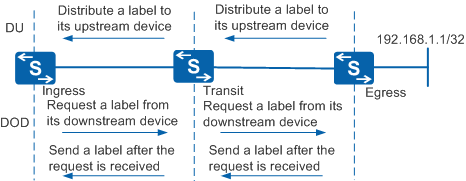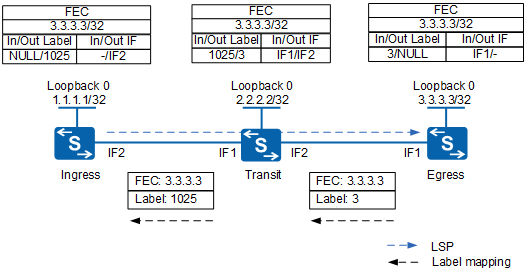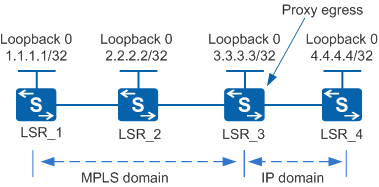LDP LSP Setup
LDP peers send Label Request and Mapping messages to advertise FEC-to-label mappings and establish LSPs based on mappings. Label distribution and management depend on advertisement, distribution control, and retention modes.
Label Advertisement and Management
Label Advertisement Mode
An LSR distributes a label to a specified FEC and notifies an upstream LSR of this label. This means the label is specified by a downstream LSR and distributed from downstream to upstream.
Two label advertisement modes are available and label advertisement modes on upstream and downstream LSRs must be the same, as shown in Table 1.
Label Advertisement Mode |
Definition |
Description |
|---|---|---|
Downstream Unsolicited (DU) mode |
An LSR distributes a label for a specified FEC without receiving a Label Request message from an upstream LSR. |
As shown in Figure 1, the downstream egress node actively sends a Label Mapping message to the upstream transit node to advertise the label for the host route 192.168.1.1/32. |
Downstream on Demand (DoD) mode |
An LSR distributes a label for a specified FEC only after receiving a Label Request message from an upstream LSR. |
As shown in Figure 1, the downstream egress node sends a Label Mapping message to the upstream transit node to advertise the label for the host route 192.168.1.1/32 after receiving a Label Request message from the ingress node. |

When the DU mode is used, LDP distributes labels to all peers by default. Each node sends Label Mapping messages to all peers without distinguishing upstream and downstream nodes. If LSRs only distribute labels to upstream peers, they must identify their upstream and downstream nodes based on routing information before sending Label Mapping messages. Upstream nodes cannot send Label Mapping messages to their downstream nodes. If upstream/downstream roles change because corresponding routes change, new downstream nodes send Label Mapping messages to their upstream nodes. This slows down network convergences.
Label Distribution Control Mode
Label distribution control modes are used on the LSR during LSP establishment. There are two label distribution control modes: Independent and Ordered.
Independent mode
A local LSR distributes a label bound to an FEC and informs its upstream LSR without waiting for the label distributed by its downstream LSR.
Ordered mode
An LSR advertises mappings between a label and an FEC to its upstream LSR only when the LSR is the outgoing node of the FEC or receives a Label Mapping message from the next hop.
Table 2 describes the combination between the label distribution control mode and label advertisement mode.
Table 2 Combination between the label distribution control mode and label advertisement mode Label Distribution Control Mode
DU Mode
DoD Mode
Independent Mode
A transit LSR can assign a label to the ingress node without waiting for the label assigned by the egress node.
The directly-connected ingress transit node that sends a Label Request message replies with a label without waiting for the label assigned by the egress node.
Ordered Mode
The LSR (the transit LSR in Figure 1) must
receive a Label Mapping message from the downstream LSR (the egress node in Figure 1). Then, the transit LSR can distribute a label to the ingress node in the diagram.
The directly connected transit node of the ingress node that sends the Label Request message must receive a Label Mapping message from the downstream (the egress node in the diagram). Then, the transit node can distribute a label to the ingress node in Figure 1.
Label Retention Mode
Label retention modes refer to modes used when LSRs receive label mappings not immediately used. Label mappings received by LSRs may or may not come from next hops. There are two types of label retention modes: Liberal and Conservative.
Table 3 compares the two label retention modes.
Label Retention Mode |
Definition |
Description |
|---|---|---|
Liberal mode |
Upon receiving a Label Mapping message from a neighbor LSR, the local LSR retains the label regardless of whether the neighbor LSR is its next hop. |
When the next hop of an LSR changes due to a network topology change, note that:
|
Conservative mode |
Upon receiving a Label Mapping message from a neighbor LSR, the local LSR retains the label only when the neighbor LSR is its next hop. |
(Default) DU label advertisement mode, ordered label distribution control mode, and liberal label retention mode
DoD label advertisement mode, ordered label distribution control mode, and conservative label retention mode
LDP LSP Setup Process
LSP setup is the process of mapping an FEC to a label and advertising the mapping to neighboring LSRs. Figure 2 shows the LDP LSP setup process in DU and Ordered modes.
LDP LSP setup consists of the following steps:
By default, during route change, if an edge node (egress) finds a new host route that does not belong to any existing FEC, the egress node creates an FEC for the route.
If the egress node has available labels, it distributes a label for the new FEC and sends a Label Mapping message to the upstream node. This Label Mapping message contains the distributed label and FEC.
After receiving the Label Mapping message, the upstream transit node checks whether the sender (egress node) is the next hop of the FEC. If it is the next hop, the transit node adds the label-to-FEC mapping in the Label Mapping message to its label forwarding table, and sends the Label Mapping message of the specified FEC to the upstream LSR (ingress).
After receiving the Label Mapping message, the ingress node checks whether the sender (transit node) is the next hop of the FEC. If it is the next hop, the ingress node adds the label-to-FEC mapping in the Label Mapping message to its label forwarding table. An LSP is established, and the packets of this FEC can be forwarded based on labels.
This process establishes a common LDP LSP. A proxy egress establishes LSPs using routes in which the next-hop addresses are not local addresses. If penultimate hop popping (PHP) is enabled, an LSR at the penultimate hop is a specific proxy egress along an LSP. A proxy egress is configured manually and applies to a network with MPLS-incapable switches or helps load balance traffic based on Border Gateway Protocol (BGP) routes.
Figure 3 shows the proxy egress of an LDP LSP.
In Figure 3, LSR_1, LSR_2, and LSR_3 are in an MPLS domain. LSR_4 is not enabled with or does not support MPLS LDP. If a policy is configured to use all IGP routes to establish LDP LSPs, LSR_3 functions as a proxy egress and becomes the penultimate hop of the routes. This allows LSR_1, LSR_2, and LSR_3 to establish LDP LSPs to LSR_4.


